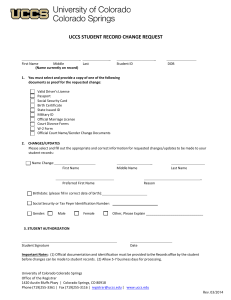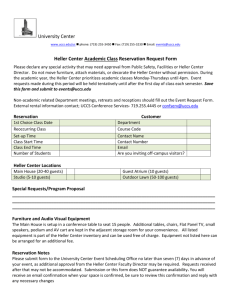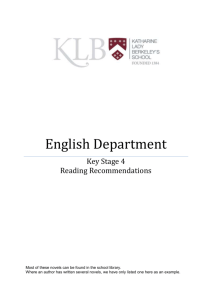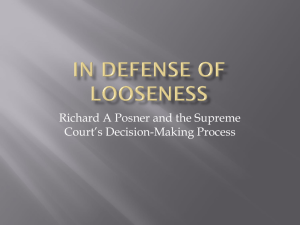Document 10401060
advertisement
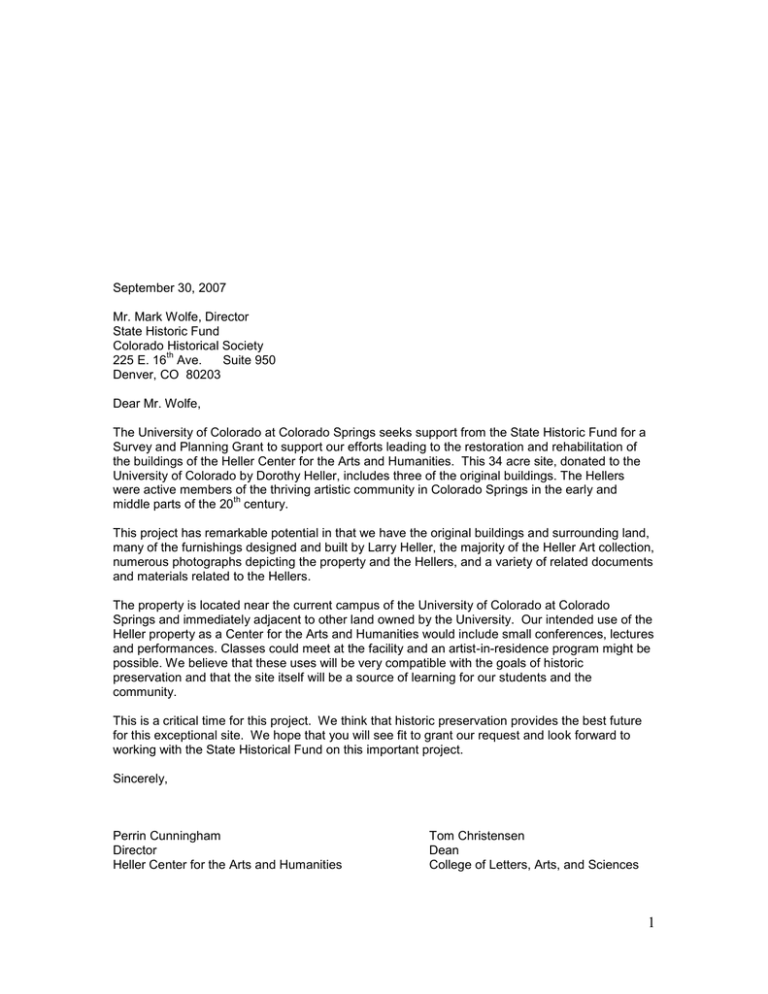
September 30, 2007 Mr. Mark Wolfe, Director State Historic Fund Colorado Historical Society th 225 E. 16 Ave. Suite 950 Denver, CO 80203 Dear Mr. Wolfe, The University of Colorado at Colorado Springs seeks support from the State Historic Fund for a Survey and Planning Grant to support our efforts leading to the restoration and rehabilitation of the buildings of the Heller Center for the Arts and Humanities. This 34 acre site, donated to the University of Colorado by Dorothy Heller, includes three of the original buildings. The Hellers were active members of the thriving artistic community in Colorado Springs in the early and th middle parts of the 20 century. This project has remarkable potential in that we have the original buildings and surrounding land, many of the furnishings designed and built by Larry Heller, the majority of the Heller Art collection, numerous photographs depicting the property and the Hellers, and a variety of related documents and materials related to the Hellers. The property is located near the current campus of the University of Colorado at Colorado Springs and immediately adjacent to other land owned by the University. Our intended use of the Heller property as a Center for the Arts and Humanities would include small conferences, lectures and performances. Classes could meet at the facility and an artist-in-residence program might be possible. We believe that these uses will be very compatible with the goals of historic preservation and that the site itself will be a source of learning for our students and the community. This is a critical time for this project. We think that historic preservation provides the best future for this exceptional site. We hope that you will see fit to grant our request and look forward to working with the State Historical Fund on this important project. Sincerely, Perrin Cunningham Director Heller Center for the Arts and Humanities Tom Christensen Dean College of Letters, Arts, and Sciences 1 GENERAL GRANT APPLICATION ORGANIZATION SUMMARY ORGANIZATION NAME: The University of Colorado at Colorado Springs ______ ADDRESS: __1420 Austin Bluffs Parkway, Colorado Springs, CO 80918______________ EMPLOYER ID #:__________________________________________________________ CONTACT PERSON: (Name) Perrin Cunningham_________________________ Director, Heller Center for Arts and Humanities ______ (Title) PHONE: Office (719) 330-3463 Fax (719)_262-4200 E-Mail__pcunning@uccs.edu PROPERTY OWNER: The Regents of the University of Colorado on behalf of the University of Colorado at Colorado Springs____________________________________________________ (if different than above) (Name) ADDRESS: 1420 Austin Bluffs Parkway, Colorado Springs, CO 80918_____________ PROJECT TYPE: Acquisition and Development NAME OF PROPERTY/PROJECT: Education XX Survey and Planning Heller Estate _ PROJECT LOCATION: __1150 Eagle Rock Road, Colorado Springs, CO 80918____________ BRIEF DESCRIPTION OF REQUEST: _Preservation master plan and structures assessment. _____________________________________________________________________________ _____________________________________________________________________________ _____________________________________________________________________________ AMOUNT OF REQUEST: Grant Request: $91,450.00 Cash Match: $48,093.00 Total: $139,543.00 ______________________________________________ Signature of Legally Authorized Representative __________________ Date _______________________________________________ Signature of Legal Owner __________________ Date 2 A. Narrative 1. Applicant Information a. Description of the applicant organization, its mission statement, goals, and objectives A small, artist-built, adobe compound is nestled in a wide valley, brimming with native grasses and wildflowers. Surrounded by dedicated open space and backed by towering sandstone bluffs, the valley opens to a panoramic view of Pikes Peak and the Garden of the Gods. Songbirds and eagles vie for attention. This is a beautiful, peaceful place. And it is in the geographic center of sprawling Colorado Springs. Donated in 1999 to the University of Colorado at Colorado Springs (UCCS) for use as a center for arts and humanities, the future of this extraordinary property is at a critical juncture. Until recently, UCCS was pursuing a plan that was not focused on historic preservation. The campus is now exploring how to develop a comprehensive master plan for the entire 34 acres with an emphasis on historic preservation. We are requesting Survey & Planning grant assistance from the State Historical Fund to complete this master plan. The supporters of The Heller Center wish to develop a plan that considers “the preservation of those materials, features, finishes, spaces, 1 and spatial relationships that, together, give a property its historic character.” This has not been the only plan for the Heller Center. Another approach under consideration would irrevocably alter both the land and the remaining structures to fit the project to the existing budget. However, due to the present support from the current UCCS administration in response to efforts from UCCS faculty and students, there is a window of opportunity for exploring the possibility of taking the path of historic preservation/rehabilitation for the future work on this important site. By promoting the preservation/rehabilitation plan, we will galvanize existing fundraising potential. The students, faculty, and community at large support the respectful rehabilitation of the property. These constituencies are particularly concerned that the Heller Center respect the heritage of the site and of the people who once lived there. This heritage represents a distinct era in the history of Colorado Springs, a period of transition between an older, smaller, more eccentric town to a larger, suburban, and more homogeneous city. The Heller Center, part of the College of Letters, Arts, and Sciences (LAS) is a learning community dedicated to the pursuit of knowledge through creative engagement with an emphasis on the arts and humanities. UCCS affirms the traditional goals of a university: the creation, interpretation, dissemination, and application of knowledge. The Heller Center’s goals are to provide collaborative programs that enrich the community, promote the creation of a vibrant and creative cultural life, strengthen and sustain a productive and responsible economic sector, and advance an understanding and practice of civic duty and responsibility. The Heller Center objectives are to provide a working center for the arts and humanities including exhibition and small performance spaces, studios, seminar areas, meeting spaces, a working greenhouse and gardens, and an artist/scholar-in-residence program. In addition, the Heller Center program includes active collaboration with 1 per The Secretary of the Interior’s Standards for the Treatment of Historic Properties, 1995 3 Colorado arts organizations, local, regional, national, and international artists, and scholarly organizations emphasizing the arts and humanities. b. Description of the organization’s history UCCS was founded in 1965, as part of the University of Colorado system, on the site of the former Cragmor Sanatorium in Colorado Springs. The Heller Center was established in 2001. In donating her property to UCCS, Dorothy Heller wished to honor the memory of her husband, artist Lawrence Heller, through the creation of a center for arts and humanities. c. Description of programs and accomplishments with particular attention to historic preservation projects UCCS is a relatively new campus. The Heller project presents one of our only opportunities to pursue historic preservation and, thus, to uphold the trust the students, faculty, and greater community place in UCCS to value and respect our collective heritage. In the late 1990’s, under a different campus administration, UCCS undertook a remodel of its Main Hall, with an Historic Structure Assessment from the State Historical Fund. The work conducted resulted in loss of historic integrity and the community requested de-listing of the building. However, Chancellor, Dr. Pamela Shockley-Zalabak, and her present leadership team, support rehabilitation efforts for the Heller Center and wish to work successfully with the State Historical Fund on this project. Most importantly, the leadership team has given the Heller Center the opportunity, at this time, to pursue work with the State Historical Fund. UCCS has the ability to professionally organize, manage, and complete this project, as indicated by its successful management of hundreds of grants each year and by the track record of recent campus building projects with budgets ranging from several million dollars to $53 million. 2. Purpose of Grant a. Description of the importance of the property or project The purpose of this Survey & Planning project is to develop a comprehensive plan for 2 the preservation, restoration, and/or rehabilitation of the site so that we may best realize Mrs. Heller’s wish for an arts center while maintaining the essential historic character of the site. A comprehensive survey and plan will also help determine the architectural/cultural/historical significance of the site and thereby help us seek appropriate designation to provide protection and funding for the site. In addition, the project will identify suitable areas and specific treatments for historical preservation, restoration, and/or rehabilitation. Moreover, this project is a significant component of our outreach efforts to the community regarding the importance of historic preservation. It will allow us to budget accurately for the future rehabilitation and restoration of the property and enhance our fundraising abilities for the long-range goals of the entire Heller Center project. 2 per The Secretary of the Interior’s Standards for the Treatment of Historic Properties, 1995 4 The property was an important cultural site from the 1930’s through the 1950’s. It was the Colorado home of artist Lawrence Heller (1905-1983), a member of the Broadmoor Art Academy, and his wife Dorothy Heller (1902-1999), Colorado Springs’ first female police officer. The hand-built adobe compound was visited by Frank Lloyd Wright and many artists including Randall Davey, Boardman Robinson, Tabor Utley, Archie Musick, Lew Tilley, and Starr Kempf. The Alexander Film Company, of Colorado Springs, used the location, and Heller’s various talents, for many of its productions. Heller wrote scripts, acted, performed stunts, and designed sets and costumes. The compound was an active part of the flourishing mid-century arts scene in Colorado Springs. The Hellers, and their friends, also raced sports cars, foxhunted, and played “prairie golf” on the property. Larry Heller’s initial importance as an artist lay in his spectacular ability as a portrait painter. But he developed his own particular vision of the West. In a 1998 interview with the Pikes Peak Library District, artist and art collector Tracy Felix said: Larry Heller differs from almost everyone else. His works are uniquely linked to the iconic movie images we all saw growing up. In his book on the arts in Colorado Springs, muralist Archie Musick wrote about Larry Heller that he was “an amazing craftsman – Larry Heller could not hold his interest down to painting alone, but branched out into ceramics, sculpture, wrought iron, metal lathe work, and 3 photography.” Archie left out architecture. This is true and quite unusual. It’s hard to find an artist who can paint and sculpt. It’s usually one or the other. You rarely see artists who do it all. But Heller wanted to do it all and he ended up doing it all. He did everything, including architecture. He designed all of the buildings he lived in and they expanded as his whims did. He did beautiful bronze sculpture that remain today as monuments of his work. His painting, his illustration – he did posters for World War II efforts, he did a lot of different things in art. In life, all of his recreational activities are quite eccentric for a simple community like Colorado Springs – the fox hunting and the race car driving. He had so many interests that it makes him unique. It is a great thing for people to go to the Heller Ranch and see the entire 4 collection in its original location. It’s almost all there. The Heller Center curates the Heller Collection, consisting of hundreds of paintings, sculptures, ceramics, hand-wrought fixtures, works-on-paper, photographs, and movies. The collection will return to the property when the restoration is complete. In addition to The Heller Center’s collection, pieces of Larry Heller’s work are found in private collections and in the collections of the Sangre de Cristo Arts Center in Pueblo, CO; in the A.R. Mitchell Museum in Trinidad, CO; and at Carnegie-Mellon University in Pittsburg, PA. In 2004 an exhibit of Heller’s work was held at the Sangre de Cristo Arts Center entitled Rococo Cowboy: The Painting and Sculpture of Larry Heller. The Hellers built the compound themselves, with help from various friends. Two of the remaining three buildings on the site were among the first rammed-earth structures in El Paso County. Built in the 1930s, during the Pueblo Revival period (1905-1940), they have flat roofs with low parapets and vigas. The original battered walls, with 3 Archie Musick, Musick Medley: Intimate Memories of a Rocky Mountain Art Colony, 1971 4 Pikes Peak Library District, The Renaissance Artist of Colorado Springs, video, 1999 5 straight-headed windows, are stucco on the exterior and plaster on the interior. UCCS has original fixtures, tiles, and furniture all designed and made by Heller, and used on the property. Currently, the buildings and site are used very little due to their deteriorating condition. The more recent gallery building is used for environmental studies classes. The current condition of the buildings is poor. However, the essential character of the buildings and site remain. Our goal is to return it to the condition of its earlier, significant period. This is one of the only examples of the type of architecture remaining in El Paso County and it is surrounded by a virtually unaltered landscape. Its cultural significance is two-fold: first, as an encapsulation of the vibrant period of the 1930s-1950s, and, second, as an art venue for future generations. Once rehabilitated, the Heller Center will be a unique venue for the community and surrounding Pikes Peak region. Given the extraordinary setting and the appealing character of the buildings, we anticipate considerable and diverse usage by the University (faculty across the named disciplines, students, artists, visiting scholars, conferences), local school districts, civic organizations, private entities (such as corporations having retreats), and individuals (weddings). b. Goals and objectives for the grant project The project goals and objectives are to carry out a planning process for the entire Heller site, including an Historic Structure Assessment, per State Historical Fund guidelines. We will also create a comprehensive master plan for the site including recommendations for the appropriate level of historic designation (local/state/national), recommendations for historic landscapes, a plan for rehabilitation of historic structures, a plan of location of possible new structures (in relation to historic structures to protect their integrity and defining features), and a plan for location of utilities and other infrastructure. We will use the results of the plan to facilitate future decision-making and fundraising efforts. The project will provide recommendations for specific treatments for preservation and/or rehabilitation in accordance with The Secretary of the Interior’s Standards for the Treatment of Historic Properties. A general structural assessment of the Heller property was conducted in 2005. It was not an historic structures assessment. A cultural resources survey for the entire UCCS campus was conducted in 1998-99 by the Department of Anthropology with assistance from Colorado State Historical Fund Grant #98-02-026. In that report, Intensive Cultural Resources Survey: Cragmor Campus, University of Colorado at Colorado Springs, the Heller Center, Smithsonian number SEP3189, is classified as historical and eligible, with the management recommendation to preserve. The Heller Center will provide the public with the opportunity to follow the project through a series of open seminars, colloquia, and workshops. We will create a webpage featuring updates of the project and conduct an on-going tour series. UCCS faculty and students will use the project as a springboard for their own research on preservation and sustainability and we will engage primary and secondary students through community outreach programs on the city’s artistic heritage. There are no long-term preservation covenants or easements on the property at this time except for those made by UCCS and Mrs. Heller in the gift agreement. The restrictions on use of the property, per Mrs. Heller’s gift agreement, are the following. The land must be maintained to preserve its beauty and tranquility as an open space 6 and park. It must remain free of disruptive vehicular traffic or thoroughfare, subdividing, roads, easements, or buildings, in violation of the gift covenants. We understand that if future funding is provided by the State Historical Fund for physical work it will result in covenants on the property. These are compatible with Mrs. Heller’s gift. No temporary construction, mobile homes, or prefab buildings are allowed. No dormitories, residence halls, or student quarters are permitted. No public road is allowed through the land. The award of this Survey & Planning grant will result in preservation/rehabilitation planning work that would not otherwise be accomplished and will allow us to leverage the benefit through partnerships with other organizations and individuals. While we have raised over $500K toward the overall project, these funds are restricted to construction/rehabilitation/preservation uses and cannot be used for project planning and assessment. c. Public benefit of the work proposed The primary audience of this project is students, faculty, neighbors, school children, and cultural communities. It will provide UCCS students and faculty with a “real-time” example of historic preservation, and all of its complexities and interdisciplinary connections, for their own projects and research. It will demonstrate the process of historic preservation/rehabilitation planning to the wider public. The Heller Center will actively seek to benefit under-represented groups, working with our Assistant Vice-Chancellor for Diversity and engaging in community outreach efforts. This project provides an important link to the local economy. The award of this grant will help engage the community in a collaborative effort to preserve and rehabilitate the Heller property. We expect the renovated Heller Center to be a site for heritage tourism. We also expect the Heller Center to be a venue for artistic performances, small conferences, corporate retreats, and social functions. This project enjoys wide community support. UCCS will provide a 25% cash match of funds. Student, faculty, and community volunteers will be available to assist as needed. Major gifts for the overall project have been received from Joan and Bob Donner, and the estate of Mrs. Betty Taylor, totaling over $500K, and earmarked for the restoration/preservation/rehabilitation of the main house and surrounding grounds. An additional $20K from Lyda Hill has been received for work on the guesthouse. In addition, $38K has been raised from donations of under $1,000, many of $50 or less, from a broad spectrum of the Front Range and Southern Colorado communities. At this time, $200-$300K in future support has been pledged by private donors and additional support has been indicated if this grant is awarded. The Heller Center will also receive an endowment from the estate of Chan Bergen to provide for the maintenance of the property. d. Timetable for implementation Grant award Contract with SHF Select and contact consultants History and Research tasks Historical structure assessment Master Plan Development Start Date Feb 1, 2008 April 1, 2008 April 15, 2008 May 1, 2008 June 1, 2008 September 1, 2008 Completion Date February 1, 2009 7 This project is urgently needed because the buildings and site are in a deteriorated condition. There is currently a great deal of momentum for carrying out this type of planning to ensure the long-term protection of the property for the State Historical Fund approach. The cash match is in place for this project. Finally, the project has the support of the current administration at UCCS. e. Other participating organizations We are applying for additional grant assistance on this Survey & Planning project. We are requesting grants from the Bee Vradenburg Foundation on January 1, 2008, and the National Trust Preservation Funds on February 1, 2008. f. Long term sources/strategies for funding at the end of the grant period We plan to use the results of the survey and planning grant to create a long-term fundraising strategy and maintenance plan. We are requesting National Trust funds for assistance with a fundraising plan. We will be seeking additional State Historical Fund grants for Acquisition & Development and for Education projects. As part of the fundraising plan, we will be designating ways to increase the endowment for the property and provide for future maintenance. 3. Evaluation a. Expected results during the funding period Comprehensive site plan including Historic Structures Assessment, per State Historical Fund guidelines; rehabilitation plan, per Secretary of the Interior Guidelines; establishment of period of historical significance; historical landscape assessment; location recommendations for new structures, utilities, and infrastructures in relationship to historic areas, and determination of designation level to pursue. b. How success will be defined and measured We will have a complete master plan, which we can use as a tool in our decisionmaking and assist with our fundraising efforts, and we will be poised to move forward, in accordance with the master plan, with Acquisition and Development grants and education projects. c. How the results of the project will be used or shared with others Future projects for preservation/rehabilitation, fundraising, and educational outreach will be based upon the results of this Survey & Planning project. We will incorporate the process and results of this project into UCCS classes and student/faculty research. 8 NAME OF APPLICANT:_The University of Colorado at Colorado Springs__________________ NAME OF PROJECT:_Preservation Plan_____________________________________ PROJECT # (Leave blank) ____________ ATTACHMENT 1 SCOPE OF WORK Note: All work will be conducted by professional historic preservation consultants meeting the Secretary of the Interior’s Professional Qualifications Standards. Regular consultations between UCCS and SHF will take place throughout the project. All work will be subject to State Competitive Bid Rules for qualification-based selection of professional consultants and construction contractors. I. History and Research Tasks A. Conduct Preliminary Research B. Gather property information C. Photograph site D. Consultation with National, State and Local Register staff E. Conduct additional research to provide historic context for nomination F. Prepare map per nomination requirements G. Prepare nomination form H. Attend Review Meeting II. Historic Structure Assessment (per SHF guidelines) A. Assess Site Features 1. Prepare project base map from client provided survey 2. Review available data and conduct additional research on site history 3. Conduct site investigations 4. Identify and assess extant historic site features, patterns and relationships 5. Prepare existing condition plan and summary text of findings 6. Identify and assess architectural components of structures 7. Assess structural components 8. Assess electrical components 9. Assess mechanical and plumbing components 10. Develop opinion of probable cost for HSA B. Complete Historic Structure Assessment report III. Master Plan Development A. Review background data including Site Survey and Historic Structure Assessment B. Develop and confirm site program C. Develop conceptual site plan alternatives that meet program needs and that preserve the structural and historic integrity of the site taking into account the following: 1. Circulation, site access and parking, restoration of historic site features (trees, fields, etc.) 2. Rehabilitation of extant site features, patterns and relationships, future uses, and stabilization 3. Conceptual site plan alternatives for core building area 4. Preparation of illustrative graphics to explain conceptual site alternatives and preferred alternatives 9 D. Provide two conceptual master plan schemes based on the premise of rehabilitation of the structures E. Present alternatives F. Choose appropriate Master Plan alternative G. Develop Preferred Master Plan 1. Prepare preferred site plan alternative 2. Develop preferred site plan alternatives for core building area 3. Develop building concepts 4. Provide utility/civil recommendations for selected Master Plan alternative 5. Provide structural implications narrative for preferred Master Plan alternative 6. Provide electrical implications narrative for preferred Master Plan alternative 7. Provide mechanical implications narrative for preferred Master Plan alternative 8. Provide “Order of Magnitude” costs for Master Plan 10 NAME OF APPLICANT:_The University of Colorado at Colorado Springs__________________ NAME OF PROJECT:_Preservation Plan_____________________________________ PROJECT # (Leave blank) ____________ ATTACHMENT 2 PROJECT BUDGET TASK Grant Request Cash Match Total 6,200 0 6,200 29,810 5,000 34,810 3,570 0 3,570 25,860 5,000 30,860 Structural Assessment 6,850 0 6,840 Electrical Assessment 2,290 0 2,290 Mechanical Assessment 4,380 0 4,380 Cost Estimation 4,500 0 4,500 Reimbursables * 8,000 500 8,500 Historical Research Landscape Architecture Civil Engineering Architecture UCCS Archival & Research Assistance 0 13,248 13,248 UCCS Program Planning 0 1,434 1,434 UCCS Design and Planning 0 2,150 2,150 UCCS Report Preparations/Oversight 0 2,560 2,560 29,892 121,342 18,201 18,201 $48,093 $139,543 SUBTOTAL 91,450 ICR @ 15% 0 TOTALS $91,450 *Reimbursables include: copies, plots, long distance telephone, faxes, bluelines, film and film developing, lodging, meals, travel, airfare, etc.Only actual expenses will be billed (at 1.1 X their cost). Round all numbers to the nearest whole dollars. For example, $145 not $144.67. Line items must define the costs of the project such as contractual services, travel costs etc., and indicate the rates, hours, miles, etc. for such costs. The totals on this page should match the totals on the Organization Summary page. Please verify that the numbers in all columns and rows add correctly. 11 NAME OF APPLICANT:_The University of Colorado at Colorado Springs__________________ NAME OF PROJECT:_Preservation Plan_____________________________________ PROJECT # (Leave blank) ____________ ATTACHMENT 3 PHOTOGRAPHS 12
